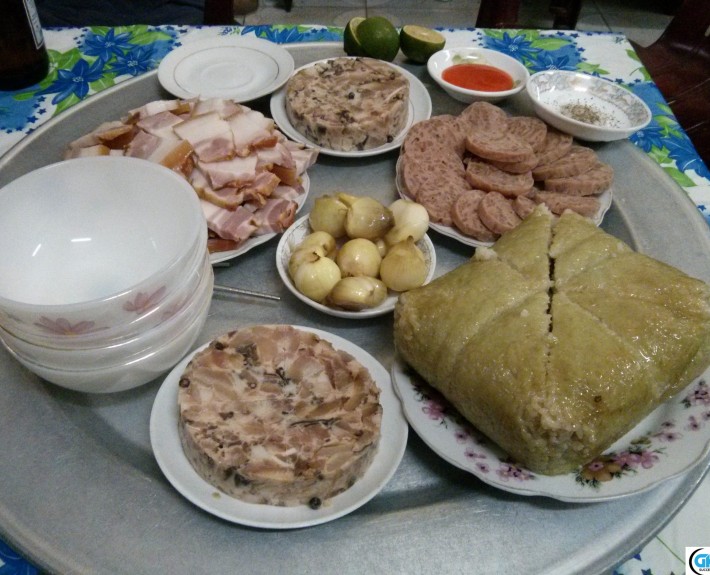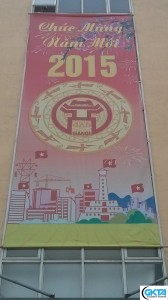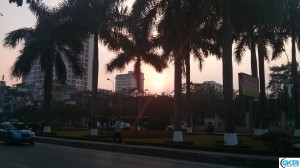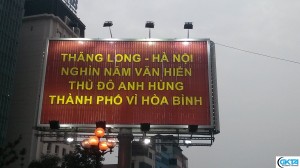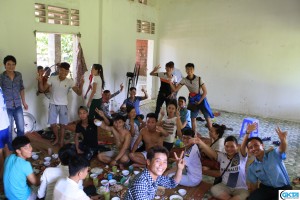The Bootstrap Alley Tour in Hanoi
- Hub.IT founder Bobby Liu. Credit: Yoann Fauche
- The winning team, Echoes. Credit: Yoann Fauche
- Anh Minh Do of Tech in Asia and the judges. Credit: Yoann Fauche
- OnOnPay founder Sy Phong. Credit: Yoann Fauche
- #HotTab founder Sanjeev Sapkota. Credit: Yoann Fauche
Last Wednesday night, a panel of local and regional judges selected Echoes as the winner of the Bootstrap Alley Tour in Hanoi and set things in motion for the multi-national team to attend the upcoming Tech in Asia Singapore startup conference on May 6 and 7. The three judges were Ronnie Wee, founder and managing partner of Incuvest (based in Singapore); Quan Nguyen, venture partner at Inspire Ventures (based in Ho Chi Minh City); and Ben Liu, director of Kamia (based in Taipei).
Around 100 people squeezed into co-working space and incubator Hub.IT in Hanoi’s Hoan Kiem district for the event (as part of a ten city journey), which will lead up to the tri-annual Tech in Asia Singapore startup conference. Approximately sixty entries were trimmed down to the Top Five teams, each of which was given five minutes to make the case to win free tickets and accommodation, and a booth at the startup conference. After each pitch, the judges provided feedback and probed some of the teams’ assumptions. All entries had to be an internet, mobile, or hardware-software startup with, at minimum, a prototype ready to demo.
Advice, Experience, and Vision
Before the Top Five teams pitched, a fireside chat was held with the three visiting judges. During this segment, the judges shared their views on operating in Vietnam, the greater region, and why it’s important to think ahead. Between them, the judges have made investments in companies in Vietnam, greater Asia, and North America in spaces such as Internet of Things (IoT), education, logistics, internet services, and digital currencies.
For Ben Liu, one of the key considerations when evaluating a deal is the founder’s strategy and market, i.e., “have they convinced me that this team and this market are the best?” Teams should have a good understanding of what market comes next, and how to grow and accelerate; one of the best ways to do that is to reach out through your network and find local resources. It does not mean jumping into the market—first network, learn what you need to know and then make your move.
Ronnie Wee explained that investment decisions are based on the team and market execution—which means understanding a team’s thought process and execution plan. A team should be able to be a good regional player and understand the nuances of different markets. Look at potential partners, prove and show traction—a team’s thinking process should be clear for investors, meaning that a team has gone through and begun to identify gaps. Do research and validate your assumptions.
Quan Nguyen pointed out that a product by itself can’t stand alone: “Can you make your strategy happen? Do you have the connections?” Many startups don’t think about going abroad because a big opportunity can sometimes be scary. However, a team than can scale needs to have the ability to cross borders. Different scenarios require different plays (especially as an investor) so it’s important to have an idea where and how to exit.
Overall, the judges drove consistent points to the audience: thinking beyond your home market, building and having a network in place to form vital partnerships, and having a viable execution plan to scale the business.
The Top Five Teams
AZ Stack provides a way for developers to include peer-to-peer (P2P) calling and messaging over low bandwidth in their applications by simply adding a few lines of code. Founder Quang Mai Duy and the rest of his team are initially targeting local developers and software companies in order to gain traction.
#HotTab (meaning Hotel Tablet) was another strong contender for the top prize. Founder Sanjeev Sapkota had a vision to solve basic communication issues between hotel staff and guests via in-room tablets. The new in-room technology addresses guests needs and provides enhanced services by partnering with companies like Food Panda, GrabTaxi, TicketBox, and others.
OnOnPay is a way to top-up your mobile phone credit with the added bonus of receiving gifts, 20% more of the top-up value, lucky draws, or other rewards. Founder Sy Phong (who has experience in the telecommunications industry) is aiming to launch the service by May 2015.
GCall is a way for online retailers to provide customer service to shoppers in their own native languages. As shown on a mockup, the service itself appears on an online product’s page as a distinct icon so that a shopper can select the icon and be connected to a customer service representative (CSR). The CSR can then go ahead and help the customer with his/her purchase, which can range from answering questions to a more proactive approach.
The winning team, Echoes, presented a novel way to conduct audio tours but the tool itself can be customized to meet a variety of needs. The project, led by Josh Kopecek, originated from a Hanoi Soundwalk held in 2013. Echoes is essentially two parts: the creator web app and the consumer mobile app linking content with users. The team has several promising pilot projects in the works, including clients in Hanoi and Copenhagen, and at least one global brand has expressed interest in the technology behind Echoes.
Key Takeaways
Whether your model is a copycat or you are targeting a blue ocean, you still have to get the fundamentals down. The consensus was that the pitches were good, clear, and well rehearsed; one judge claimed that the Top Five in Hanoi were the best batch yet. Indeed, it was a great sight to see fresh faces, expats, locals, and visitors come together to witness the excitement, passion, and motivation that all the founders had for their respective products and services.
After the event, some of the teams received additional critical feedback directly from investors—advice which can be used to refine their pitches for the next time, thereby bringing them one step closer to realizing their dreams. More broadly, Wednesday’s event brought together and strengthened the open and inclusive startup community in Hanoi. Ultimately, Tech in Asia’s Bootstrap Alley Tour has helped raise the bar here in Hanoi.
The next stop on the Bootstrap Alley Tour will be in Hong Kong on March 10.






